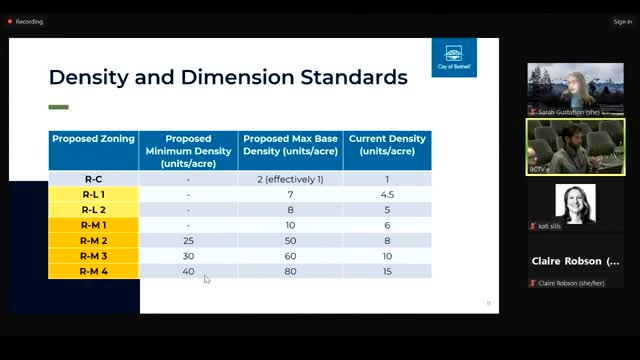Debate ignites over housing density and development standards
October 04, 2024 | Bothell, King County, Washington
This article was created by AI summarizing key points discussed. AI makes mistakes, so for full details and context, please refer to the video of the full meeting. Please report any errors so we can fix them. Report an error »

In a recent government meeting, officials discussed critical zoning regulations and housing density targets aimed at addressing the region's growing housing needs. The conversation centered on the challenges posed by existing zoning laws, particularly for small lots encumbered by critical areas such as wetlands and steep slopes.
The current zoning code allows for a maximum base density of two units per 40,000 square feet, but many lots are constrained by environmental factors. Officials raised concerns about the feasibility of establishing a minimum density requirement that exceeds current maximums, particularly for standalone homes on small lots. The proposed minimum density could reach 40 units per acre, which may be unattainable for smaller sites, potentially limiting redevelopment opportunities.
Commissioner Westerbeck emphasized the need to rethink suburban development standards to accommodate more urban-style housing. He noted that while increasing density is technically feasible, existing regulations on parking, setbacks, and open space often hinder development. Westerbeck suggested that allowing developers more flexibility could lead to innovative housing solutions, particularly near urban centers like the University of Washington Bothell.
The discussion also highlighted the importance of monitoring growth over the next five years to assess whether current assumptions about housing demand hold true. Officials acknowledged that adjustments may be necessary based on the outcomes of this monitoring.
As the meeting concluded, the key question posed to attendees was whether to maintain the proposed minimum density or align it with existing maximums. The outcome of this decision could significantly impact future housing development in the area, shaping the region's response to its housing crisis.
The current zoning code allows for a maximum base density of two units per 40,000 square feet, but many lots are constrained by environmental factors. Officials raised concerns about the feasibility of establishing a minimum density requirement that exceeds current maximums, particularly for standalone homes on small lots. The proposed minimum density could reach 40 units per acre, which may be unattainable for smaller sites, potentially limiting redevelopment opportunities.
Commissioner Westerbeck emphasized the need to rethink suburban development standards to accommodate more urban-style housing. He noted that while increasing density is technically feasible, existing regulations on parking, setbacks, and open space often hinder development. Westerbeck suggested that allowing developers more flexibility could lead to innovative housing solutions, particularly near urban centers like the University of Washington Bothell.
The discussion also highlighted the importance of monitoring growth over the next five years to assess whether current assumptions about housing demand hold true. Officials acknowledged that adjustments may be necessary based on the outcomes of this monitoring.
As the meeting concluded, the key question posed to attendees was whether to maintain the proposed minimum density or align it with existing maximums. The outcome of this decision could significantly impact future housing development in the area, shaping the region's response to its housing crisis.
View full meeting
This article is based on a recent meeting—watch the full video and explore the complete transcript for deeper insights into the discussion.
View full meeting
